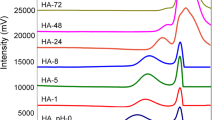Abstract
When the viscosity of hyaluronic acid (HA) solution was measured with a rotational visco-meter, depolymerization occurred only by leaving the sample in the cup of the viscometer, while the solution in a glass test tube at the same temperature, 37 °C, was practically stable during the entire period of investigation. As the parts where the sample solution had contact with the viscometer are stainless steel, the participation of metal ions in the depolymerization was suspected. Therefore, experiments were carried out with stainless-steel beads in the HA solution. The results show that the molecular weight of HA decreased on exposure to the beads under aerobic conditions. The addition of 10 beads to 2 ml of a 0.1% HA solution prepared with 0.2 M NaCl reduced the molecular weight to about 75% of the initial value after 4 h. The degradation rate was proportional to the surface area of the beads. However, no dissolution of metal ion was detected, and therefore, this reaction was thought to proceed at the surface of the metal.
Similar content being viewed by others
Author information
Authors and Affiliations
Additional information
Received: 26 September 1997 Accepted: 27 November 1997
Rights and permissions
About this article
Cite this article
Miyazaki, T., Yomota, C. & Okada, S. Degradation of hyaluronic acid at the metal surface. Colloid Polym Sci 276, 388–394 (1998). https://doi.org/10.1007/s003960050257
Issue Date:
DOI: https://doi.org/10.1007/s003960050257




